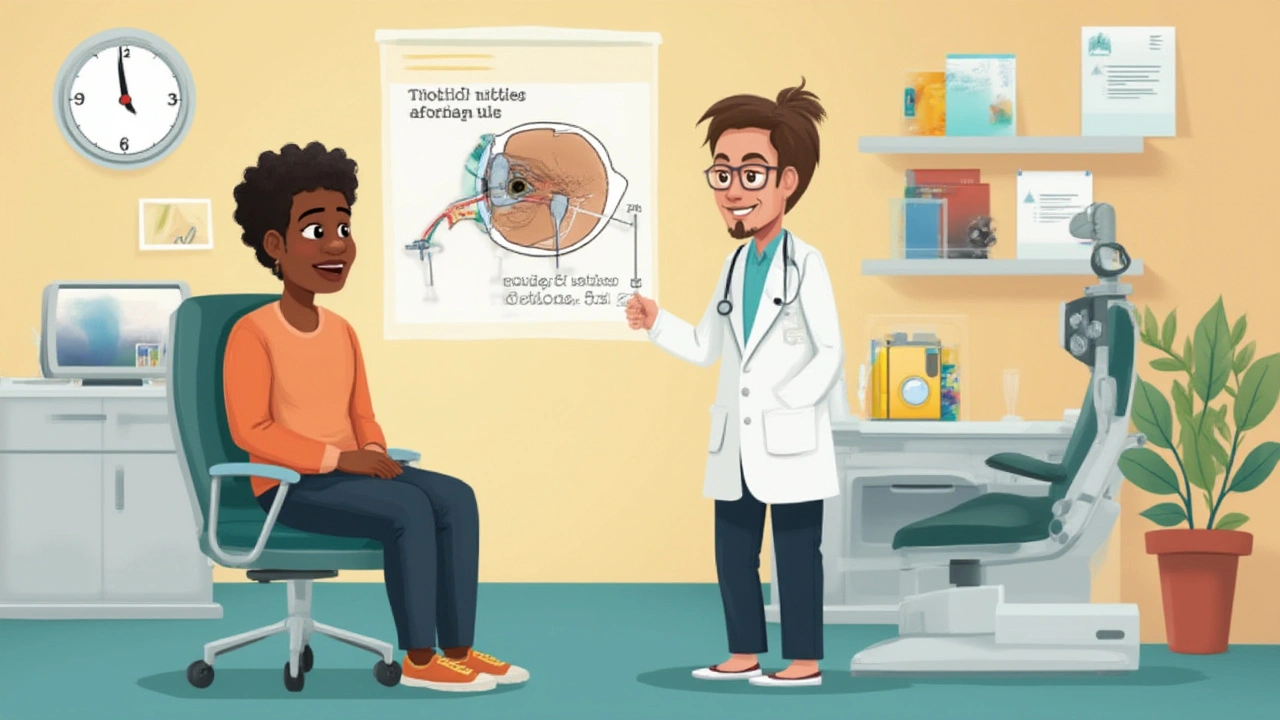Ever used an eye drop and thought, “Whoa, things look a little weird now”? If your doctor handed you a little bottle called timolol, you might know what I’m talking about. Timolol is more than just a tough tongue-twister – it’s a go-to solution for eye pressure, especially if you’re fighting glaucoma or that stubborn aftermath of cataract surgery. But what happens after those first drops hit your eye? Let's unpack what vision changes you might run into, how common they are, and what’s actually happening to your peepers, so you can feel more in control and less freaked out.
How Timolol Works and Why It’s Prescribed
Timolol is a beta blocker. Sounds intimidating, but think of it as a peacemaker for your eye’s plumbing system. It dials down how much fluid your eye makes, bringing the pressure inside your eyeball down to safe levels. This is especially important if you have glaucoma—a condition that, left unchecked, can sneakily steal your vision away. Around 80 million people worldwide are living with glaucoma, and more than half don’t even know it, according to the World Health Organization.
Most often, doctors prescribe timolol as an eye drop (timolol maleate). It’s pretty popular for primary open-angle glaucoma and sometimes for ocular hypertension. Some folks also get it for secondary glaucoma or as extra help after operations involving the eye. If your doctor chose this medicine, they probably had a specific reason, especially if you’re at higher risk for vision loss.
Now, here’s where it gets interesting. Because timolol also finds its way into the bloodstream straight through the eyes, it can tinker with more than just eyeball mechanics. That means what you experience isn’t just about your vision—it could be about your entire body’s response, too. Ever feel a little tired after using your drops? That’s not your imagination; systemic effects are possible, although they’re usually less dramatic than local eye effects.
Let’s break down what happens when timolol goes to work. Once you put in the drops, about 20–50% is absorbed through your conjunctiva and nasal passages. This rapid absorption is why doctors suggest closing your eyes and pressing gently on the inside corner after each drop. Kind of like putting a cork in a bottle to keep the good stuff inside—less medicine sneaks off to your bloodstream that way.
If you’re thinking, "This is a lot for an eye drop," you’re not wrong. Timolol's special because it’s effective but—like any good medicine—comes with its own list of quirks and side notes. But what about vision changes, specifically?

Common Vision Changes and Side Effects with Timolol
Here’s the thing with timolol: Most people slide through treatment just fine. But about 1 in 10 will notice something’s a little off with their sight at first. For starters, the classic one is blurred vision, usually right after you use the drop. It feels like someone smeared Vaseline on your window to the world. This blur mostly fades after a few minutes, but it can trip you up if you’re grabbing your morning coffee or trying to check your phone in the rush.
Some users notice mild stinging or a sensation that something gritty entered the eye. It’s more annoying than painful, but worth knowing in advance. Occasionally, colors look washed out, or there’s a change in how you see lights and shadows. This isn’t like a scene from a sci-fi film, but some folks say headlights look starbursty or that reading in dim lighting isn’t as crisp.
Lucky for most, these effects fade within 20–30 minutes. If you’re someone whose day is packed, timing the drops so blurry spells don’t hit while driving or reading makes life easier. Here’s a tip: set a timer for 15 minutes post-drop before any close-up work or driving.
The less common but more stubborn side effects can linger: dry eyes, red eyes, or a sense of tiredness in your eyes (kind of a heavy-lid feeling). Those with dry eye syndrome already might feel a bit worse, and some folks develop new dry eye symptoms. Lubricating eye drops can help, and there are preservative-free options if your regular tears feel too harsh. For redness, giving your eyes mini breaks—like looking out a window or closing your eyelids for 10 seconds—can offer relief.
Visual field changes—where you feel you’re losing parts of your side vision—aren’t usually timolol’s fault directly, but if this happens, it could mean your underlying glaucoma isn’t controlled. If you see new floaters, flashes, or dark spots, don’t delay—this needs a doctor's attention ASAP.
Let’s look at a snapshot of how often certain vision changes happen with timolol, based on post-marketing surveillance and clinical trials:
| Side Effect | Chance of Occurrence |
|---|---|
| Temporary blurred vision | ~ 10–20% |
| Mild eye discomfort/stinging | ~ 10–15% |
| Dry eyes | ~ 4–6% |
| Redness | ~ 3–8% |
| Visual field loss | <1% (usually from underlying condition, not the drug) |
It’s worth noting that the majority (about 70%) adjust to the drops with minimal impact. But it never hurts to keep a quick note on your phone about how your vision feels; it’ll help your doctor fine-tune your regimen if needed.

Tips for Managing Timolol’s Effects and Protecting Your Vision
Okay, you’re stuck with these drops for a while, so how do you make life easier? Here are some straightforward tricks that can help you roll with the changes and keep your vision as sharp as possible.
- Plan your drops around your schedule: If you notice temporary blur, use the drops right before watching TV or chilling, and let your eyes clear up before jumping into busy tasks.
- Pinch your inner eye corner (nasolacrimal occlusion): Press gently for 1–2 minutes post-drop to keep more medication in your eye and less in your bloodstream. It makes a bigger difference than you'd expect, especially if you’re sensitive to medicine effects.
- Use lubricating drops if dryness kicks in: Go for preservative-free versions if you’re dosing more than 4–6 times a day or your eyes get irritated easily.
- Stay hydrated: Dehydration tends to worsen dry eye and fatigue. Even mild dehydration can make you feel more uncomfortable with eye drops.
- Bring sunglasses on bright days: If your eyes feel extra sensitive to light or you catch halos around lights outside, a good pair of sunglasses cuts the glare and protects your eyes from UV rays.
- Keep a journal: Sounds corny, but jot down changes—blur, redness, dryness, or floaters. If problems persist or new vision problems pop up, you and your doctor will spot a pattern quicker.
- Follow-up is everything: Glaucoma and other eye pressure problems need regular measurement. Show up to your appointments and let your eye doctor know exactly what’s happening, even if it feels minor.
- Don’t skip doses or double up: Missing a dose won’t instantly harm you, but don’t double up next time. Stick as closely as possible to your routine for the best pressure control.
Lots of people ask if timolol can cause permanent vision loss. The short answer: it’s not likely unless you’re allergic, not following your doctor’s plan, or have a rare reaction. If you already have advanced eye disease, catching new vision changes early with regular checks remains your best defense.
One more thing—most doctors recommend checking your blood pressure and pulse when using timolol. It sounds out of place, but since it’s a beta blocker, it can sneakily lower your heart rate, especially if you use systemic beta blockers for your heart. Keep an eye on dizziness, fainting, or unusual fatigue, and let your primary care doctor know if you notice these effects.
Here’s the real deal: Timolol is a powerful sidekick in fighting glaucoma and high eye pressure, but like any superhero, it comes with its own quirks. Knowing what vision changes are normal and having a plan to roll with them can make the journey smoother. If you’re ever unsure, your eye doc is your best teammate—they’ve seen it all, and there’s nothing too silly to bring up.

Skye Hamilton
i used timolol for 3 months and my vision got weirder every week. like, colors looked like they were dipped in watercolor. my doctor said it was 'normal' but i felt like my eyes were slowly turning into a bad photoshop filter. now i use laser treatment instead. no more blurry mornings.
Maria Romina Aguilar
I’ve read the studies. I’ve read the warnings. I’ve read the patient forums. And yet… I still don’t trust this drug. Not because it’s dangerous-but because it’s too convenient. Too easy. Too… pharmaceutical. Why not try acupuncture? Or herbal teas? Or… I don’t know… just breathing?
Brandon Trevino
The 10-20% blurred vision statistic is misleading. Clinical trials exclude patients with preexisting dry eye or systemic beta blocker use. Real-world incidence is closer to 35%. Also, timolol’s systemic absorption is underestimated. Plasma concentrations can reach 0.5 ng/mL after 30 minutes. That’s enough to lower HR by 10-15 bpm in sensitive individuals. Your doctor didn’t tell you this because they’re not pharmacologists.
Denise Wiley
I was terrified to start timolol after my mom lost her vision to glaucoma. But honestly? The drops saved my sight. Yeah, my eyes feel dry sometimes. Yeah, I can’t read my phone right after applying. But I can still see my granddaughter’s face. That’s worth a little blur. And yes, I cry when I put them in. Not from pain-from gratitude.
Hannah Magera
I just started timolol last week and my eyes feel weird. Like, not painful, but… tired? Like I didn’t sleep. Is that normal? I’m scared to ask my doctor because I don’t want to sound dumb.
Austin Simko
Big Pharma owns your eyes. Timolol is a Trojan horse. They want you dependent. They want you blind. They want you paying monthly. Look up the 1987 FDA memo. It’s all there.
Nicola Mari
I cannot believe people are still using this. In my day, we didn’t need chemical crutches. We had discipline. We had patience. We had sunlight. And we didn’t whine about blurry vision like toddlers. If your eyes are bothering you, perhaps you should stop staring at screens for 12 hours a day. Just a thought.
Sam txf
This post is basically an ad for Merck. Timolol is a beta blocker. Beta blockers cause depression. Depression causes suicide. You think your blurry vision is bad? Try waking up and not wanting to live because your meds turned your brain to mush. I’ve seen it. I’ve lived it. Don’t be another statistic.
Michael Segbawu
America is weak. We take pills for everything. In Russia they just stare at the sun for 10 minutes a day and their eyes get stronger. In China they use acupuncture. In India they drink turmeric milk. But here? We just drop chemicals in our eyes like we’re making a cocktail. Pathetic.
Aarti Ray
i used timolol in delhi and my eyes got so dry i couldnt blink properly. my aunty said try aloe vera gel on eyelids. it worked better than the drop. no more burning. no more blur. just calm. also my chai tastes better now
Alexander Rolsen
You’re all missing the point. Timolol is a gateway drug. First it’s eye drops. Then it’s oral beta blockers. Then it’s antidepressants. Then it’s disability. Then it’s a lifetime of Medicare dependency. This isn’t medicine. It’s institutional control disguised as healthcare. Wake up.
Leah Doyle
I’ve been on timolol for 2 years and I still cry when I put it in. Not because it hurts-but because it’s the only thing keeping me from losing my sight. I made a little ritual: I say thank you to my eyes before I drop it. It sounds silly. But it helps. And if you’re scared? You’re not alone. 🫂
Alexis Mendoza
There’s a deeper question here: Why do we accept vision as something we must chemically manage? Is it the body failing? Or is it our environment-screens, light pollution, stress-that’s failing us? Timolol treats the symptom. But maybe we should be asking: What are we doing to our eyes that makes this necessary in the first place?
Michelle N Allen
i read the whole thing and honestly i dont know if im supposed to be scared or relieved. i think i need to go lie down. also i think my dog is judging me for using eye drops. he stared at me for like 10 minutes after i applied them. maybe he knows something i dont
Madison Malone
Hey, if you’re new to this, you’re doing great. Blurry vision after drops? Totally normal. Dry eyes? Common. Feeling overwhelmed? So many people feel that. You’re not broken. You’re just adapting. Take it slow. Use the lubricating drops. Write down how you feel. And remember-you’re not fighting this alone. We’ve all been there.
Graham Moyer-Stratton
The state controls vision through pharmaceuticals. Timolol is not medicine. It is a tool. A tool to keep you docile. To keep you dependent. To keep you from questioning the system. Your eyes are not your own anymore. You’ve surrendered them.